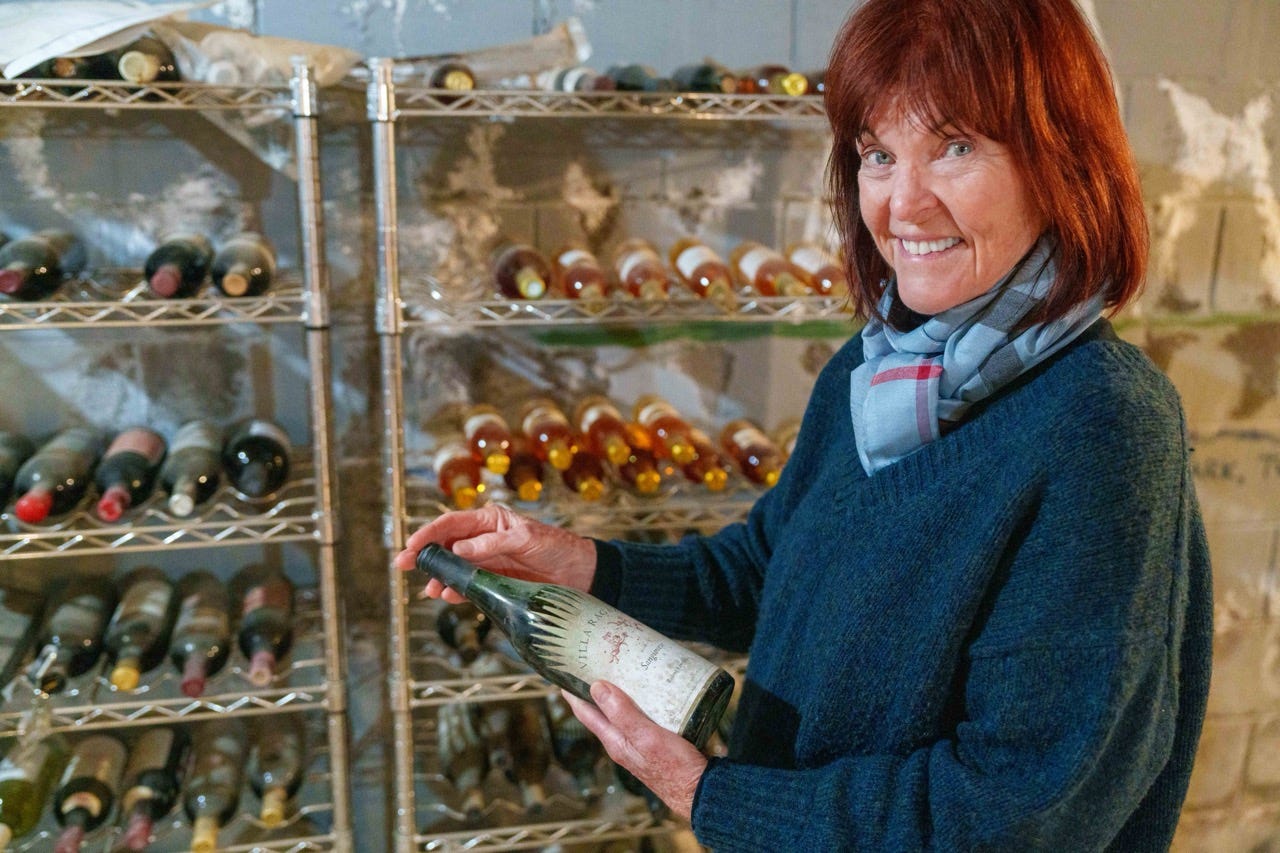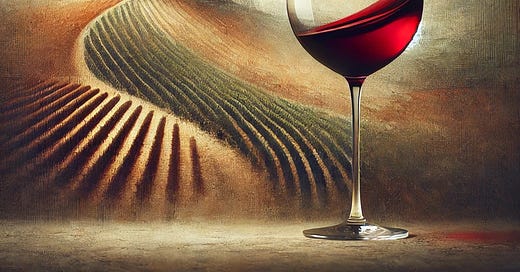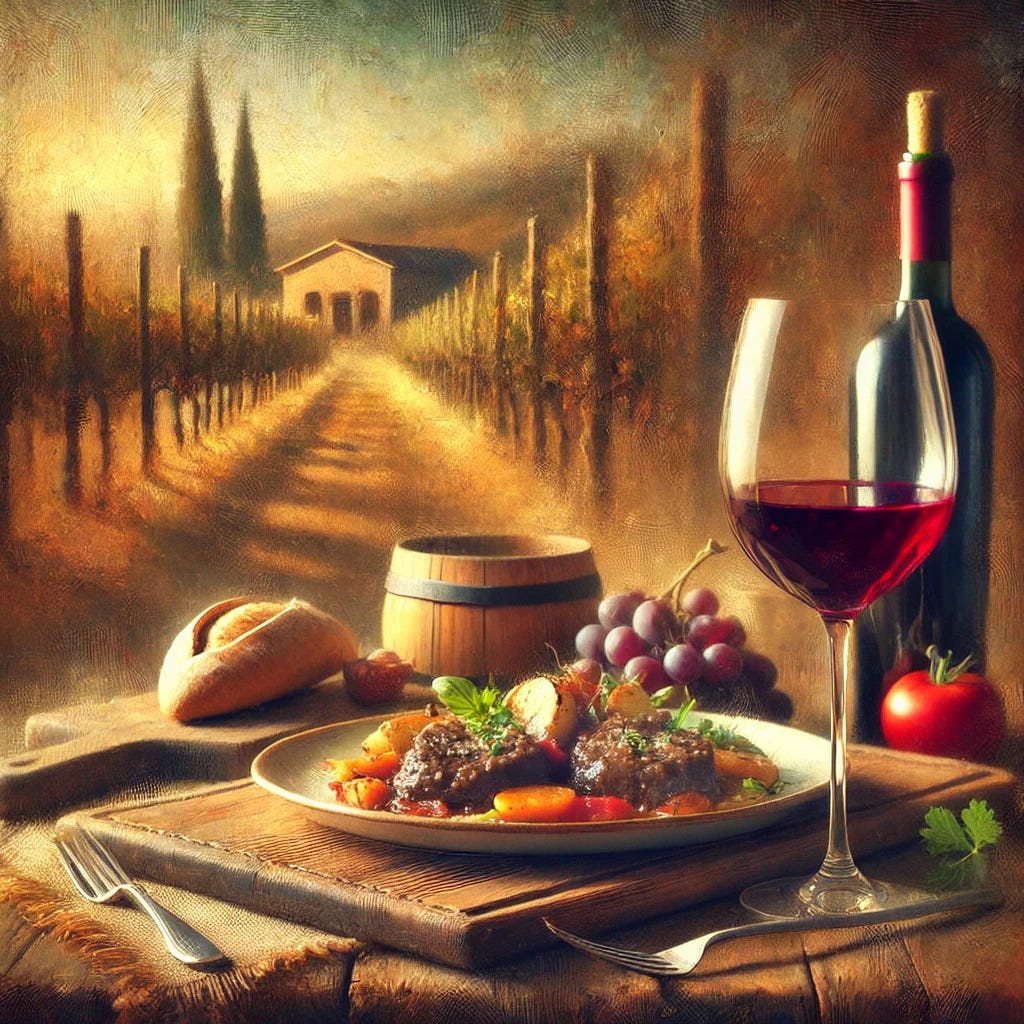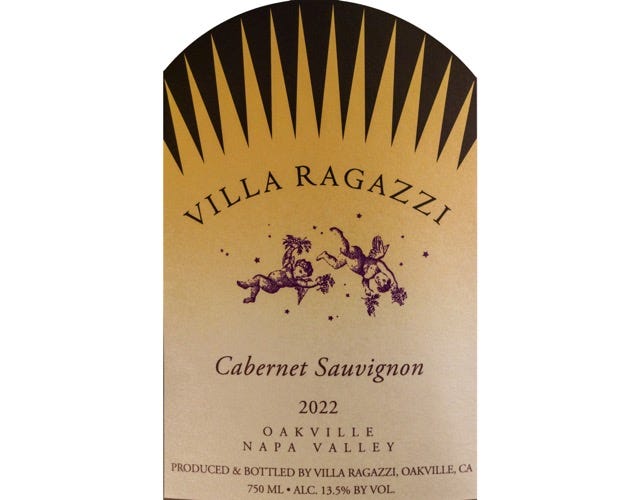Before we hear from Dan Berger, a reminder that Napa Valley Features is a subscriber-funded publication. Without support from more paid subscribers, we may have to reduce offerings like the “Wine Chronicles” or even close altogether. If you value our ad-free conflict-free veteran-owned local news, please consider becoming a paid subscriber. For as little as 16 cents a day, you can help keep local news independent, relevant and sustainable.
NAPA VALLEY, Calif. — When I was a teenager some 60-odd years ago, my parents took me to an Italian café in Los Angeles where I had my first sip of a dry red wine. I was unimpressed. Each table in the place had been staged with a bulbus bottle whose lower half was wrapped in straw; it was intended to entice visitors. The liquid was blah.
I later learned that this wine vessel is called a fiasco, which still amuses me because I only knew the word’s other meaning – an activity of ignominy, a blunder, an embarrassing mistake. I had no idea at that early stage in my culinary education that the word applied to that bottle. But fiasco was perfectly appropriate considering the typical dreariness of the wine.
A decade later, after migrating to what I considered to be fine wine (it was not!), I learned that a fiasco bottle likely contained Chianti of questionable quality. Most such Chiantis then seemed usually to have a kind of brown cast to their near-red color. They also usually had a slightly curious aroma. After tasting wines out of several fiaschi (the plural of fiasco), I was prepared to swear off all red wine forever.
Sangiovese is a noble grape that can produce superb wines — but myths and misconceptions have kept it misunderstood.
Slow forward about 70 years. I am seated next to Michaela Rodeno. We’re sipping one of the finest red wines of its type I have ever tasted. It bears no resemblance to the historic fiasco of the red-checkered-tablecloth milieu.
This is a 2019 sangiovese by the name of Villa Ragazzi, a small but prestigious Napa Valley winery project that was the dream concept of Rodeno’s late husband, Gregory, which specializes in the same grape variety that makes great Chianti and pays homage to that exalted region in Tuscany where the grape originated.
Sangiovese is a noble grape variety that can produce superb red wines that some Americans misunderstand. More myths are embedded in it than most other grape varieties, which not only limits its appeal but confines it to obscure locations in retail wine shops and restaurants.
“Most people have no idea what sangiovese is,” Rodeno said, “and even if they know that it’s a grape, they have no idea what kind of a wine it makes.”
Today’s Word Challenge
Challenge your vocabulary with this week’s mystery word. Submit your answer in the poll, and check the bottom of the page for the correct answer.
In decades of talking with ordinary wine-drinkers, I have always gotten the impression that most Americans think of Chianti, which is mainly sangiovese, as being either astringent or bitter, and that it’s not a wine that should be aged. And that serving it alongside anything other than red-sauced pastas is a faux pas.
The reality is that sangiovese is a medium-colored red-wine grape that makes a more elegant wine that’s appreciated primarily by people who like very dry wine. The only Chiantis that are brown are the bad ones, and thankfully almost none of those are left. Chianti usually is not bitter or astringent, but it is relatively tart; it’s not too difficult for amateurs to mistake tartness for bitterness.
Also, excellent examples of Chianti (and domestic sangiovese) often are better after a decade than they are on release. Brunello di Montalcino, which is 100% sangiovese, is typically best after decades. And although serving sangiovese-based wines with red-sauced pastas is a no-brainer, sangioveses can also be brilliant with an astounding array of different kinds of foods because the wines usually contain sufficient amounts of acidity to balance off the flavors in literally dozens of kinds of foods.
Aging them can benefit the better ones. Two weeks ago I pulled a bottle of 1985 Ruffino Chianti Classico from my wine cellar and opened it for friends. The wine was simply fabulous — despite nearly 40 years in the bottle. I never expected it to be as good as it turned out to be.
Chianti is best at 10 to 15 years of age; great ones are fine to roughly age 30. Quality Brunello goes even farther.
“That’s sangiovese,” Rodeno said. “It’s the acid that holds it together.”
Still, many Americans have no clue about the greatness of this wine. And one reason for that, probably, is that in the United States, deep, dark color seems to be associated with longevity. Dark color is a way of life for most red-wine producers.
For that reason, California sangioveses have often been compromised in such a way that usually makes a wine that has so little of its actual character. Many of them are simply too dark and extracted, which makes no sense to me.

I’d say that almost all neophyte wine-drinking Americans probably would reject most medium-weight sangiovese-based wines if a glass were handed to them without any explanation. All dry red wines require a bit of education, none more so than this one. But if our theoretical glass of sangiovese were handed to that same tyro with some decent food, even a simple hamburger, he or she might appreciate the wine without much elucidation.
Rodeno is a Napa Valley icon with a delightful personality. She is engaging and has an infectious laugh that belies the fact that she was the second employee to be hired in 1973 as an executive at Domaine Chandon, the French-owned star property in Yountville. Or that in 1988 she became the first female chief executive officer of a Napa Valley winery, St. Supery Vineyards and Winery – where she worked for 21 years.
Or that she and Julie Johnson, who was then at Frog’s Leap Winery, founded Women for WineSense, whose main goal was (and still is) to fight the forces of evil – the rising prohibition movement that sprang up in the 1990s and has since risen again. She also wrote a book, “Bubbles to Boardrooms: Serendipitous Stories From Inside the Wine Business.”
Villa Ragazzi (in Italian it means “kids”) is Rodeno’s small Oakville project based on sangiovese. It was founded 35 years ago and has always been so far beneath the radar that you have to be an insider to even know about it. I have been a fan of this venture for decades, but since it’s not easy to obtain the wines except by going direct or to a very few retail and restaurant locations, I’ve tasted only perhaps a dozen of them.
One reason that Villa Ragazzi’s dramatic wines are unique is that Gregory and Michaela obtained a specific clone of the grape variety that they had certified by UC Davis. It is one of few vineyards in California that is planted to this specific plant material. (Villa Ragazzi has sold some of the clonal material to other wineries.) The winery website explains:
“Sangiovese's reputation is for lighter wines – but not in our vineyard … When planted in richer soil with access to plenty of water, some Sangiovese clones can easily overcrop (grow too much fruit)” and then it produces “thin, unexciting wines. On our rocky, well-drained vineyard, the ‘Rodeno clone’ is naturally self-limiting. The full-grown vines look younger than they are, but the handsome clusters of small berries are full of flavor and color.”
I adore Rodeno’s sangioveses. To be clear, her sangioveses are not like most Chiantis. They exhibit unique elements. They have good red color but resemble fine-quality pinot noirs more than darker red wines. Nor do they have the astringency of so many inexpensive Chiantis that can occasionally have a sort of rustic character.
What sets sangiovese apart from cabernet sauvignon is that it is more difficult to grow; cabernet grows easily almost anywhere. Another difference is that aromatically sangiovese is unlike the Bordeaux varieties because it lacks the herbaceous components found in cabernet. Because it is almost citrusy and has delightful red-berry fruit components, it is compatible with tomato-y dishes but also works beautifully with savory seafood such as halibut in a butter/lime sauce or osso buco or beef stews.
It is a grape variety that can be blended with cabernet, but the risk is that if the cab addition is too much, it can dominate the sangiovese, which usually is best when it’s similar in texture to a tart pinot noir. Even a little bit too much oak or other grape variety has a tendency to disrupt sangiovese’s normal aromatics.
Villa Ragazzi also makes a tiny bit of a sangiovese/cabernet blend called Faraona. Michaela says making the blend is tricky.
“We add small amounts of cabernet until we reach a point where we can smell it. Then we back off a little bit. We want the sangiovese to be dominant.”
The 2019 Villa Ragazzi Sangiovese, one of the most stylish red wines produced in the United States, is about as authentic a wine as you can find. It comes from the superb growing region of Oakville and is comparable to a bright and refreshing Chianti with good acidity and a personality that is engaging and easy to sip. With a graceful structure, it will be best in three to five more years and will age for at least another decade.
In a certain way, the 2019 version of Villa Ragazzi reminds me of one of the best designation Chiantis, Gran Selezione, a relatively new designation. Most recent GS offerings from Italy have been the best examples of Tuscan red wine that you can find; most are even better than the acclaimed Riserva and Super Tuscan wines.
Chianti has long had a problem of image confusion precisely because of various changes in Tuscan regulations regarding what can be blended into Chianti. In the 1990s, many producers began adding cabernet to their Chianti to make Super Tuscans. This made for bigger, bolder wines that were disparaged by Chianti purists – even though many of these same wines received very high scores from U.S. critics.
The 2019 Villa Ragazzi Sangiovese... is about as authentic a wine as you can find, with good acidity and a personality that is engaging and easy to sip.
The use of cabernet in Chianti was a sort of revelation to many wine-drinkers, and it brought justified attention to the region. The wines were extremely popular for a time, notably with wine collectors. Also, the cab-infused wines started to receive extremely high scores from wine critics, some of whom who were impressed by the wines’ concentration – but who basically ignored Tuscan traditional style.
The high scores for cab-enriched Super Tuscans did not impress Tuscan wine authorities, who eventually added a new category in 2014 called Gran Selezione. The regulation required that these new wines had to be made from estate-grown fruit, be made entirely of sangiovese from the winery’s estate and be 100% sangiovese.
My enthusiasm for the Villa Ragazzi Sangiovese is based on its quality – and its price of $45 per bottle. It surely represents great value when compared with typical Gran Selezione wines that are now showing up in stores. For example, the excellent 2018 Castello di Ama GS is currently selling for about $250 per bottle; the GS from Fontodi is $90, and Castello di Volpaia’s “Coltasala” (an extremely impressive wine) is $100.
The 2019 Villa Ragazzi Sangiovese has considerable charm and freshness, with an intriguing earthiness that hints at its Italian heritage. The website says, “Our Sangiovese is always 100% varietal. This vintage shows Sangiovese's typical spicy red fruit characters and clean, bright finish due to the varietal’s natural bracing acidity, with a hint of French oak and the true red color typical of our unique Rodeno clone.
“Grown and produced in very small amounts since 1989, Villa Ragazzi Sangiovese has unusually full body and intense color … due to low yields, small berries, and the vineyard site’s suitability for growing high-quality Sangiovese, rare in Napa Valley. This is a wine with serious aging potential – we’ve enjoyed 19-year-old bottles that had years of life still in them – and offer great pleasure now.”
I’m not suggesting that the Villa Ragazzi Sangiovese is the equal of the Italian GS wines, but the beauty of Rodeno’s fruit, her dedication to these old vines, and her attention to detail positions her sangiovese as clearly one of the best New World examples – and at a price that’s extremely fair when it is compared with Tuscan versions.
Also, Villa Ragazzi makes a stylish dry rosé (Rosato de Sangiovese, $35) and the aforementioned, age-worthy 2018 Faraona, with 10% cabernet. It is $60.
The Villa Ragazzi property is located on Money Lane in Oakville.
Wine Discovery of the Week:
2022 Villa Ragazzi Cabernet Sauvignon, Oakville, Estate ($80) – This wine will not be released until probably February. Only 71 cases were produced, so this tasting note is advance notice for serious cabernet collectors who want a classic example of how good cabernet can be when it is properly harvested and made in a style that hearkens back to a time decades ago, prior to today’s bigger, richer and more full-bodied wines. It is hard to believe, but this wine has only 13.5% alcohol and an aroma of blueberries, faint traces of dried herbs, a bit of green tea and subtle tannins. At this stage, the wine is so young that it demands at least two more years of bottle-aging. That is one reason that it won’t be released until 2025.
Reader Poll:
This Week's Word Challenge Reveal:
The correct answer is E: "Dried grapes added during ferment." "Governo" is an Italian winemaking technique, first used in the 14th century and especially associated with sangiovese. Winemakers add partially dried grapes to the fermenting wine to boost fermentation, enhance flavor and improve stability — giving the wine a richer, more complex profile. We hope you enjoyed this week’s challenge and look forward to next week’s word.
If today’s story captured your interest, explore these related articles:
Dan Berger’s Wine Chronicles: Uncovering the 'Soul' of Noble Reds
Dan Berger’s Wine Chronicles: Proof That Napa’s Older Cabs Can Age
Dan Berger’s Wine Chronicles: Napa and Sonoma as True Vinous Siblings
Dan Berger’s Wine Chronicles: The Nostalgia and Nonsense of Barrel Tastings
Dan Berger’s Wine Chronicles: The Evolution and Art of Winemaking
Dan Berger’s Wine Chronicles: How Wine Is Packaged Can Affect Its Quality
Dan Berger has been writing about wine since 1975.
The views, opinions and data presented in this article are those of the author and do not necessarily reflect the official policy, position or perspective of Napa Valley Features or its editorial team. Any content provided by our authors is their own and is not intended to malign any group, organization, company or individual.









Another excellent and informative article, Dan. Thanks for highlighting sangiovese and, in particular, Chianti Classico and Brunello. The latter, as you know, can be expensive, touching the pricey Napa Valley cabernet level, but Chianti Classico is one of the more affordable fine wines out there — from quality retailers down to Trader Joe's.
I've never gotten too excited about sangiovese produced in California, though there are no doubt some good (maybe great) versions available. Your piece has given your readers some food for thought. —TP